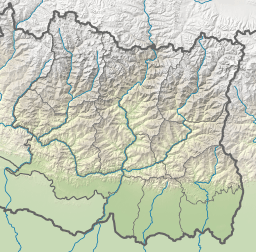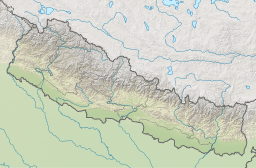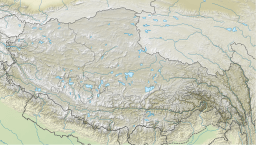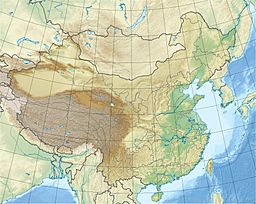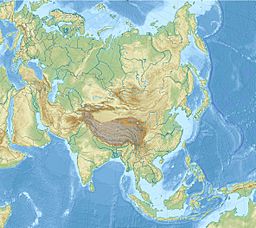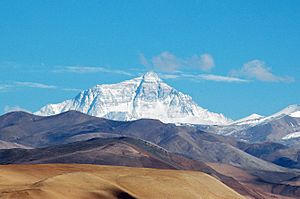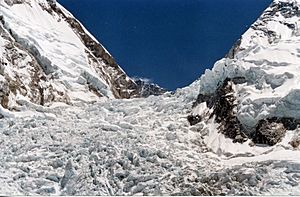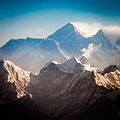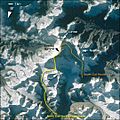Mount Everest facts for kids
Quick facts for kids Mount Everest |
|
|---|---|
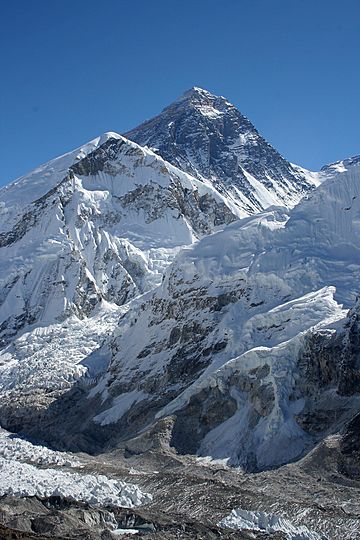
Mount Everest as viewed from Kalapatthar
|
|
| Highest point | |
| Elevation | Ranked 1st |
| Prominence | Ranked 1st (Notice special definition for Everest) |
| Listing | Seven Summits Eight-thousander Country high point Ultra |
| Geography | |
| Location | Solukhumbu District, Province No. 1, Nepal; Tingri County, Xigazê, Tibet Autonomous Region, China |
| Countries | Nepal and China |
| Parent range | Mahalangur Himal, Himalayas |
| Climbing | |
| First ascent | 29 May 1953 Edmund Hillary and Tenzing Norgay (First winter ascent 17 February 1980 Krzysztof Wielicki, Leszek Cichy) |
| Normal route | southeast ridge (Nepal) |
Mount Everest is the tallest mountain on Earth. It is part of the Himalayas, which is the highest mountain range in the world. Mount Everest stands about 8,848.00 metres (29,028.87 ft) high.
Its very top, called the peak, is right on the border between Nepal and China. High up on the mountain, there's an area called the "Death Zone." This is above 7,600 metres (24,900 ft) where the air is very thin. It's hard for people to breathe there. Climbers usually need special compressed gas tanks to help them survive in this area.
Did you know there are other mountains that could also be called "highest"? For example, the Hawaiian volcano Mauna Loa is the tallest when measured from its base deep underwater to its top. That's more than 11 kilometers! Also, Mount Chimborazo in Ecuador is the furthest point from the Earth's center. This is because the Earth bulges out a bit at the Equator.
Contents
Everest Base Camps: Starting Your Climb
"Everest Base Camp" actually refers to two main camps. These camps are on opposite sides of Mount Everest. The South Base Camp is in Nepal and is about 5,364 metres (17,598 ft) high. The North Base Camp is in Tibet and is about 5,150.00 meters (16,896.33 ft) high.
These camps are like simple shelters at the bottom of the mountain. Climbers use them to rest, get supplies, and prepare for their journey up or down the mountain. It's a place to heal and get ready for the tough climb ahead.
Climbers use the South Base Camp if they plan to go up the southeast ridge. If they're climbing the northeast ridge, they use the North Base Camp.
Supplies are brought to the South Base Camp by Sherpas or porters, often with the help of yaks. The North Base Camp can be reached by vehicles, at least during the warmer months. Climbers usually stay at base camp for several days. This helps their bodies get used to the thin air, which lowers the risk of altitude sickness.
History of Mount Everest Exploration
Mount Everest was first recorded in a survey of India in 1856. Back then, it was called Peak XV. Its first measured height was 8,840 m (29,000 ft). The mountain got its official English name, Mount Everest, in 1865 from the Royal Geographical Society.
British people started exploring the area around Mount Everest in 1921. The first serious attempt to climb to the top was in 1922. On June 8, 1924, George Leigh Mallory and Andrew Irvine tried to reach the summit. They disappeared into the fog and were never seen alive again. Mallory's body was found much later in 1999.
The very first time someone reached the top of Mount Everest was in May 1953. This amazing feat was achieved by the Sherpa Tenzing Norgay and the New Zealander Sir Edmund Hillary.
In March 2020, Nepal closed the mountain to climbers. This was done to help stop the spread of the 2019–20 coronavirus pandemic.
Sherpas: Mountain Guides
Sherpas are local people who live near Mount Everest. For them, Mount Everest is a sacred mountain. Before they climb, they often perform a special offering ceremony. Many Sherpas work as guides and porters, helping climbers reach the summit safely.
Plants and Animals of Mount Everest
There isn't much plant or animal life high up on Everest. A type of moss grows at 6,480 metres (21,260 ft), which might be the highest-altitude plant known. A cushion plant called Arenaria also grows in the region, below 5,500 metres (18,000 ft).
A special kind of Jumping spider has been found as high as 6,700 metres (22,000 ft). This might make it the highest non-microscopic animal living permanently on Earth! It hides in cracks and eats frozen insects blown there by the wind. There are likely tiny, microscopic living things even higher up.
Birds like the bar-headed goose have been seen flying at very high altitudes. Other birds, such as the chough, have been spotted as high as the South Col at 7,920 metres (25,980 ft). Yellow-billed choughs have been seen at 7,900 metres (26,000 ft). Bar-headed geese even migrate over the Himalayas. In 1953, a climber named George Lowe said he saw bar-headed geese flying over Everest's summit!
Yaks are often used to carry gear for Everest climbs. They are strong, can carry 100 kg (220 pounds), and have thick fur and large lungs. When you're around yaks or other animals in the Everest region, it's smart to stay on higher ground. They can accidentally knock people off the trail if you're on the downhill side. Other animals in the area include the Himalayan tahr, which is sometimes hunted by the snow leopard. The Himalayan black bear can be found up to about 4,300 metres (14,000 ft). The red panda also lives in this region. One expedition even found a pika and ten new types of ants!
Amazing Climbing Records
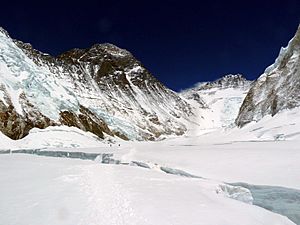
By the end of 2010, over 5,100 climbs to the summit had been made by about 3,142 different people. Here are some incredible "firsts" by climbers:
- 1922: First climb to 8,000 metres (26,247 ft) by George Finch and Captain Geoffrey Bruce.
- 1953: First successful climb to the summit by Tenzing Norgay and Edmund Hillary.
- 1960: First reported climb from the North Ridge by Wang Fuzhou, Gonpo, and Qu Yinhua of China.
- 1975: First woman to reach the summit, Junko Tabei (May 16).
- 1978: First climb without extra oxygen by Reinhold Messner and Peter Habeler.
- 1980: First winter climb by Leszek Cichy and Krzysztof Wielicki from Poland.
- 1988: First "cross-over" climb where teams went up one side and down the other. This was also shown live on TV!
- 2001: First blind climber to reach the summit, Erik Weihenmayer.
- 2004: Fastest climb to the summit with extra oxygen, by Pemba Dorje, in just 8 hours and 10 minutes.
- 2010: Youngest boy to reach the summit, Jordan Romero (13 years and 10 months old).
- 2011: Most times reaching the summit, Apa Sherpa (21 times).
- 2014: Youngest girl to reach the summit, Malavath Purna (13 years and 11 months old).
- 2022: Kami Rita Sherpa reaches the summit for the 26th time, setting a new record!
Everest's Cold and Changing Climate
Mount Everest has a very cold and snowy climate. Winds can blow incredibly fast, up to 177 mph (285 km/h). January is the coldest month, with temperatures as low as −74 °F (−59 °C). Even in July, the warmest month, it's still freezing, with highs around −10 °F (−23 °C).
| Climate data for Mount Everest | |||||||||||||
|---|---|---|---|---|---|---|---|---|---|---|---|---|---|
| Month | Jan | Feb | Mar | Apr | May | Jun | Jul | Aug | Sep | Oct | Nov | Dec | Year |
| Daily mean °C (°F) | −36 (−33) |
−35 (−31) |
−32 (−26) |
−31 (−24) |
−25 (−13) |
−20 (−4) |
−18 (0) |
−18 (0) |
−21 (−6) |
−27 (−17) |
−30 (−22) |
−34 (−29) |
−27 (−17) |
Sadly, because of climate change, the glaciers around Mount Everest might disappear in the next few decades. This would be a big change for the mountain and the surrounding environment.
Images for kids
-
Everest and Lhotse from the south. In the foreground are Thamserku, Kangtega, and Ama Dablam
-
Published by the Survey of Nepal, this is Map 50 of the 57 map set at 1:50,000 scale "attached to the main text on the First Joint Inspection Survey, 1979–80, Nepal-China border." At the top centre, a boundary line, identified as separating "China" and "Nepal", passes through the summit contour. The boundary here and for much of the China–Nepal border follows the main Himalayan watershed divide.
-
Looking up along the southern ridgeline, the face of the Hillary Step is visible. The top of the South-West face is on the left in shadow, and in the light to the right is the top of the East/Kangshung face. In 2016 and 2017 there were serious reports that the Hillary Step was changed, which triggered a big discussion in the climbing community. (2010 photo)
-
From Kala Patthar, Nepal
-
The Western Cwm ("Coom"), with Everest on the left and Lhotse to the right
See also
 In Spanish: Monte Everest para niños
In Spanish: Monte Everest para niños


